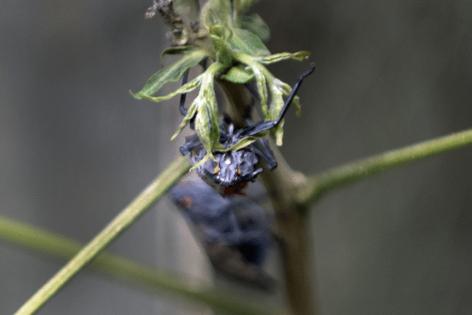Allegheny County topped Pennsylvania in spotted lanternfly reports in 2023. Will it have another blockbuster year?
Published in Outdoors
PITTSBURGH — If the scourge of the spotted lanternfly plays out as it did in Philadelphia and Harrisburg, Pittsburgh is set for another invasion this year of the icky, sap-sucking invasive insects.
Allegheny County residents for the second year in a row reported the highest number of lanternfly sightings in the state last year with 20,716, almost half the number of total reports in the state, according to data released to the Post-Gazette from the Pennsylvania Department of Agriculture.
The pesky bug could have peaked or might peak this year in Allegheny County, according to experts.
Lanternfly infestations have slowed to a trickle in areas once inundated in the eastern part of the state, including Philadelphia and Harrisburg.
"Pittsburgh folks, hang in there and hopefully the lanternfly will follow the same pattern," said Brian Walsh, lanternfly researcher and horticulture educator at Penn State Extension.
"It could be that you have another year or two before it completely peaks," he said. Or, numbers could decrease this year.
Walsh was near ground zero in 2017 when lanternfly populations exploded in the state at the border of Montgomery and Berks counties.
"People in the area were making references to biblical plagues at the time," he noted. "We see them here now, but they're nothing like they had been at their peak," Walsh said.
Spotted lanternfly populations typically surge for three to five years and then fall off, he said.
However, the number of lanternflies moving into and attacking vineyards in the fall remains stronger than in the surrounding areas in the years past the peak, he added.
A nuisance insect and its damage
They don't bite. But swarms of spotted lanternflies can plague outdoor events and damage trees and plants.
The colorful leafhopper from Asia threatens $25 billion in agricultural commodities such as grapes, fruit trees and hardwoods, according to the state Department of Agriculture.
The lanternfly damages and weakens plants and trees, especially younger plants and ornamentals, said Shannon Powers, press secretary for the Pennsylvania Department of Agriculture.
Because the bugs secrete honeydew, a euphemism for the lanternfly's sticky droppings, they can cause messes on patios and cars and mold on greenery.
"Lanternflies will mostly be a nuisance problem, and that is good," Walsh said. "It's not the fire and brimstone that we originally thought would kill trees and our forests, and that's a relief."
However, lanternflies are a major threat to vineyards.
With 52 out of 67 counties in the state under quarantine with infestations, the current battle line is just a county away from Erie County, where juice grape growers generate $54.2 million in economic activity, according to the 2023 Economic Impact Study of the Pennsylvania Wine & Grape Industries.
Greene County was added to the quarantined county list last week.
Egg masses can spread via traveling containers and palletsEgg masses can spread via traveling containers and pallets.(USDA)
Erie has been a top priority for the Department of Agriculture all along, Powers said.
The threat of lanternfly destruction in grape country comes when agritourism at vineyards is booming in Erie and elsewhere. Additionally, Pennsylvania in 2023 moved from the fifth- to the fourth-largest wine and grape producer in the country, according to Powers.
"It's a critical time," she said. "Wine and grapes as a product is so huge now, and it's growing and having the lanternfly threat at the same time."
Powers urges residents to check their boat trailers, boats, outdoor furniture and campers for egg masses, especially if they are traveling to Erie.
"The primary focus and the concern now is how to help the grape growers weather the storm," Walsh said.
Funding for lanternfly control in the proposed 2024-25 fiscal year budget includes at least $3 million from the Agriculture's rapid response disaster fund, plus other funding sources, Powers said.
Since the lanternfly hitches rides on vehicles, commercial drivers operating in quarantined counties like Allegheny are required to remove the bugs and their eggs before cross-county travel and have an anti-spotted lanternfly plan.
The quarantine prohibits moving lanternflies at any stage of life via vehicle, trailers and infested items like firewood, brush and other debris.
Residents are encouraged to report lanternfly sightings, along with photos, online or by calling 1-888-4BAD-FLY (1-888-422-3359).
Preparing for this year's invasion
If last year was any indication of the lanternfly population, some local governments, nonprofits, businesses and volunteers are prepping now for another invasion.
For this year's upcoming lanternfly season, the Pennsylvania Department of Agriculture will release more specifics in April about their work to track and control lanternfly infestations, Powers said.
The nymphs will emerge in early May.
Locally, some Girl and Boy Scout troops have already been seeking and snuffing out lanternfly egg masses on trees and outdoor surfaces and setting Penn State-designed circle traps on trees in North Park and Toms Run Nature Reserve in Kilbuck Township.
Educational outreach includes a recent lanternfly management workshop presented by the Allegheny County Conservation District in O'Hara Township for residents and others.
"Vacuuming can be effective in the nymph stage with a shop vac and circle traps are definitely what we recommend," said Hayly Hoch, natural resources outreach educator for the conservation district.
Lanternfly nymphs are flightless, hopping insects that emerge in May through July, and then metamorphose into flying adults in late July.
"We're really encouraged that folks are interested and not waiting for the sight of the adults, and thinking ahead," she said.
Hoch as well at the state Department of Agriculture stress that residents should find, remove and squish egg masses from trees and other outdoor surfaces and on boats and trailers now, before they hatch in May.
During a recent rainy day, the O'Hara Township Public Service department made circle traps to distribute free to workshop attendees.
The traps, which don't use exposed tape that can ensnare birds and other wildlife, were recommended by Penn State.
Lanternflies invaded township parks last year and residents reported damaged foliage, said Julie Jakubec, O'Hara Township manager.
They want to get ahead of the problem this year, she said.
"We are educating our folks and the public about how to help manage this invasive."
Last year, the township sent its public service employees to a lanternfly class and they set circular traps on trees in township parks where the insects congregated.
Every couple of weeks, township employees removed gallon bags filled with lanternflies. "We got a bunch of them for sure," said Todd Giammatteo, the township's public service superintendent.
"They are definitely a nuisance but aren't like the spongy moths that kill big oak trees," he said.
Jakubec compares the potential popularity of the circle traps to the Japanese beetle bags that property owners have used for that other invasive insect for years.
"If folks tell a few friends, more traps will be out," she said.
The township plans to post the specs for the Penn State circle traps online.
What researchers know
"We don't understand all of the underlying factors that are driving population trends," Walsh said.
Allegheny County residents reported slightly more lanternflies in 2022 than in 2023, with 24,156 sightings. However, reports don't necessarily reflect true population numbers, making it difficult to make predictions.
What Walsh can say with certainty is populations can dramatically drop and increase in localized areas. But he and other researchers don't know why the populations suddenly flatline.
"There are competing theories out there including natural population dynamics, natural predators, resources being depleted, or it could be something as simple as the weather," he said.
Also noteworthy is that lanternfly infestations occur within pockets of a region. "It can be five miles or less before you see another major infestation. We don't know why."
There is still much to learn.
For example, the Japanese beetle populations will cycle up and down. "You can have a really high population in one area and then you might not see them again for several years."
But can the spotted lanternfly have the same pattern?
Researchers don't know, though they can guess based on other insect populations, Walsh said. "At this point, we're staring into a crystal ball.
Are there more or fewer lanternflies in Pennsylvania than in the past?
"We've really struggled to quantify populations as a whole simply because their habitat is inaccessible in treetops. It's difficult to get counts, and they are constantly moving. Trying to track a moving target that small, it's difficult."
But given their range has expanded, he said, there probably are more lanternflies in the state.
(c)2024 the Pittsburgh Post-Gazette Distributed by Tribune Content Agency, LLC.







Comments